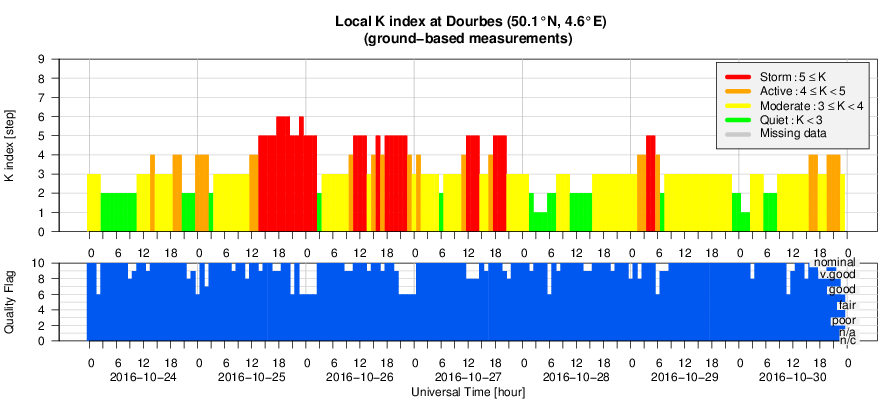- Table of Content
- 1.The sun 10 yea...
- 2.PROBA2 Observa...
- 3.Review of sola...
- 4.The Internatio...
- 5.Review of geom...
- 6.Geomagnetic Ob...
- 7.Review of iono...
- 8.Future Events
2. PROBA2 Observations (24 Oct 2016 - 30 Oct 2016)
3. Review of solar activity
4. The International Sunspot Number
5. Review of geomagnetic activity
6. Geomagnetic Observations at Dourbes (24 Oct 2016 - 30 Oct 2016)
7. Review of ionospheric activity (24 Oct 2016 - 30 Oct 2016)
8. Future Events
The sun 10 years in STEREO
Early October 26, 2006 the two STEREO spacecraft were launched. The twin spacecraft had to observe the Sun in stereo. Both have a similar orbit as the earth, one ahead, the other trailing behind.
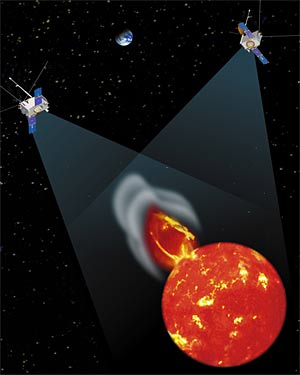
In the 10 years that passed, STEREO was of special help to forecast space weather. Especially at the time STEREO A was situated on the right side of the Sun and STEREO B on left, viewed from Earth. This was a privileged position to follow solar clouds travelling direction Earth. A side view makes it easier to estimate the speed of an object. When an object is travelling exactly along the line connecting you and the object, it is even hard to say if it is towards or away from you!
Once the two spacecraft were on the far side of the Sun, we had an excellent view on the far side of the Sun. Since the Sun turns around its axis, it gave a valuable preview on what was going to happen days later.
Of course, we can’t let 10 years of STEREO just pass like that. During the tutorial at the European Space Weather Week, two key persons will be interviewed. We want to learn all about the human interest stuff there is. Science is written down in papers, but the juicy stories not.
PROBA2 Observations (24 Oct 2016 - 30 Oct 2016)
Solar Activity
Solar flare activity was very low during the week.
In order to view the activity of this week in more detail, we suggest to go to the following website from which all the daily (normal and difference) movies can be accessed: http://proba2.oma.be/ssa
This page also lists the recorded flaring events.
A weekly overview movie can be found here (SWAP week 344).
http://proba2.oma.be/swap/data/mpg/movies/weekly_movies/weekly_movie_2016_10_24.mp4
Details about some of this week’s events, can be found further below.
If any of the linked movies are unavailable they can be found in the P2SC movie repository here
http://proba2.oma.be/swap/data/mpg/movies/
Friday Oct 28
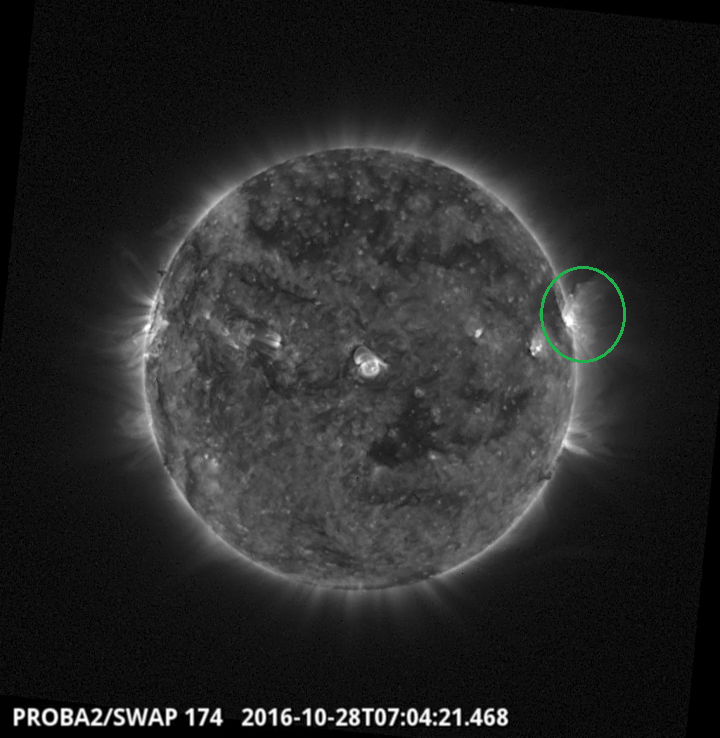
NOAA AR 2603 produced the largest flare of the week, a B3.1 class flare, which peaked at 07:17 UT on October 28. This group was the most active one throughout the week, producing several B-class flares.
Find a movie of the events here (SWAP movie)
http://proba2.oma.be/swap/data/mpg/movies/20161028_swap_movie.mp4
Review of solar activity
Solar flaring activity was very low and restricted to low-level B-class flares.
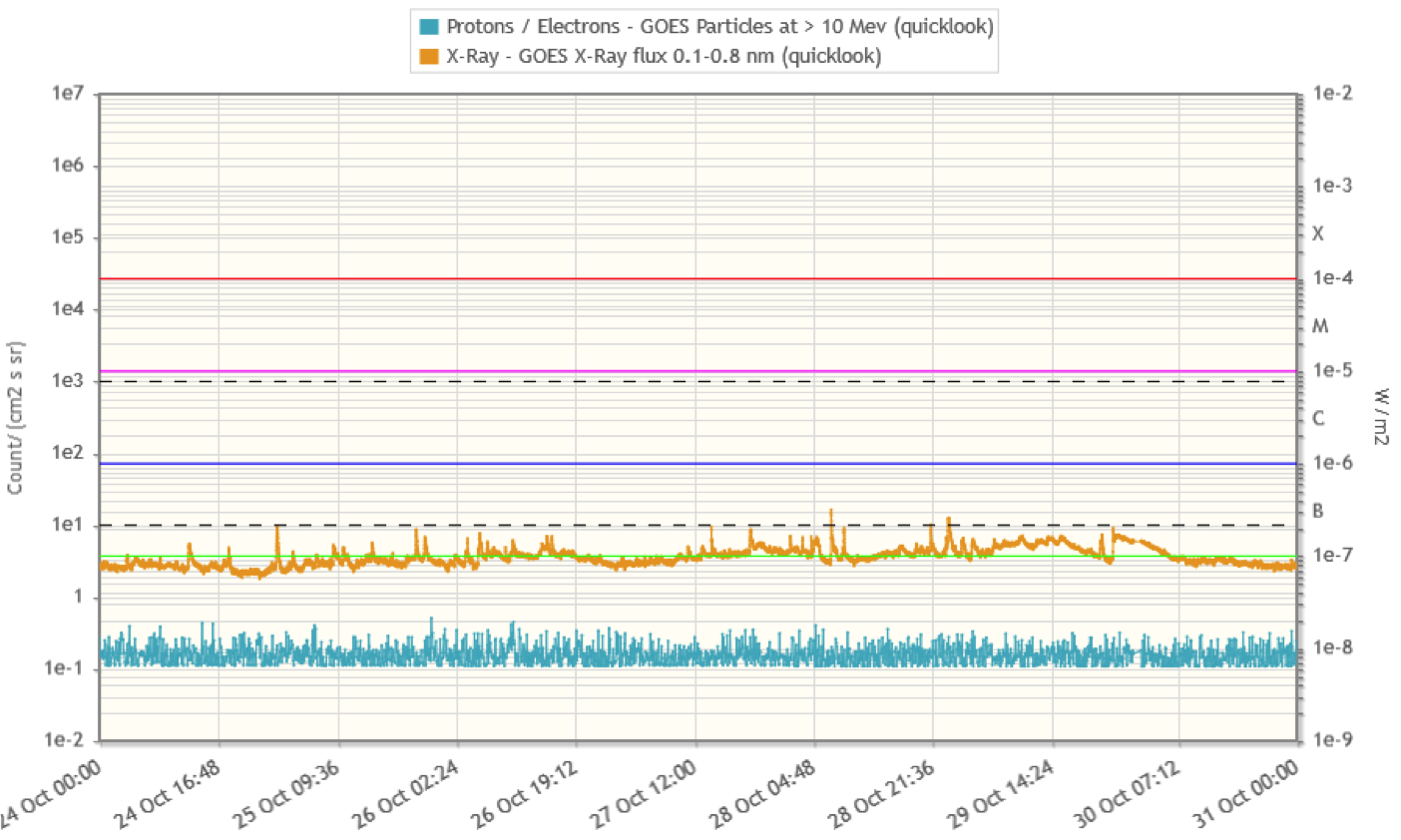
Only three small sunspot groups were observed, with NOAA 2603 the most active region producing a B3.1 flare on 28 October before rounding the northwest limb.
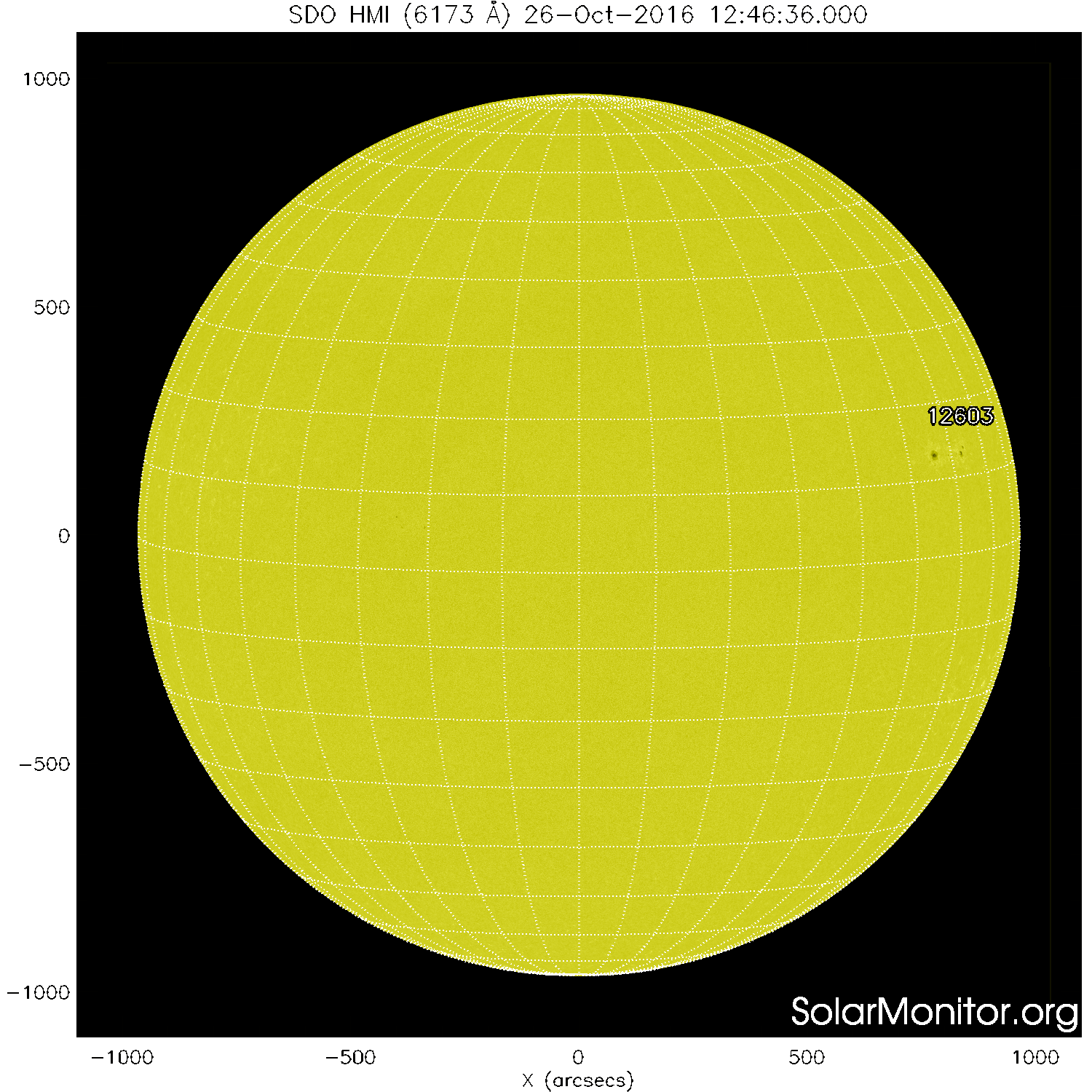
No earth-directed coronal mass ejections (CMEs) were observed. The most solid CME, a partial halo event observed late on 25 October, was associated with an eruption on the Sun's far side.
You can check this movie: http://www.stce.be/movies/c2_combo_27Oct2016.mp4
The International Sunspot Number
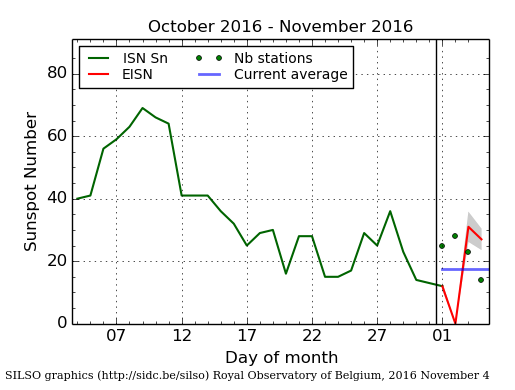
The daily Estimated International Sunspot Number (EISN, red curve with shaded error) derived by a simplified method from real-time data from the worldwide SILSO network. It extends the official Sunspot Number from the full processing of the preceding month (green line). The plot shows the last 30 days (about one solar rotation). The horizontal blue line shows the current monthly average, while the green dots give the number of stations included in the calculation of the EISN for each day.
Review of geomagnetic activity
For most of the week, the earth-environment was under the influence of the high-speed solar wind stream (HSS) from a huge positive coronal hole (CH). The co-rotating interaction region (CIR) preceding the HSS arrived around 08UT on 25 October. It was quickly followed by a steep increase of the solar wind speed from its pre-CIR range between 380 and 420 km/s to its maximum value near 830 km/s around 23UT on the same day (DSCOVR data, purple graph in the second panel).
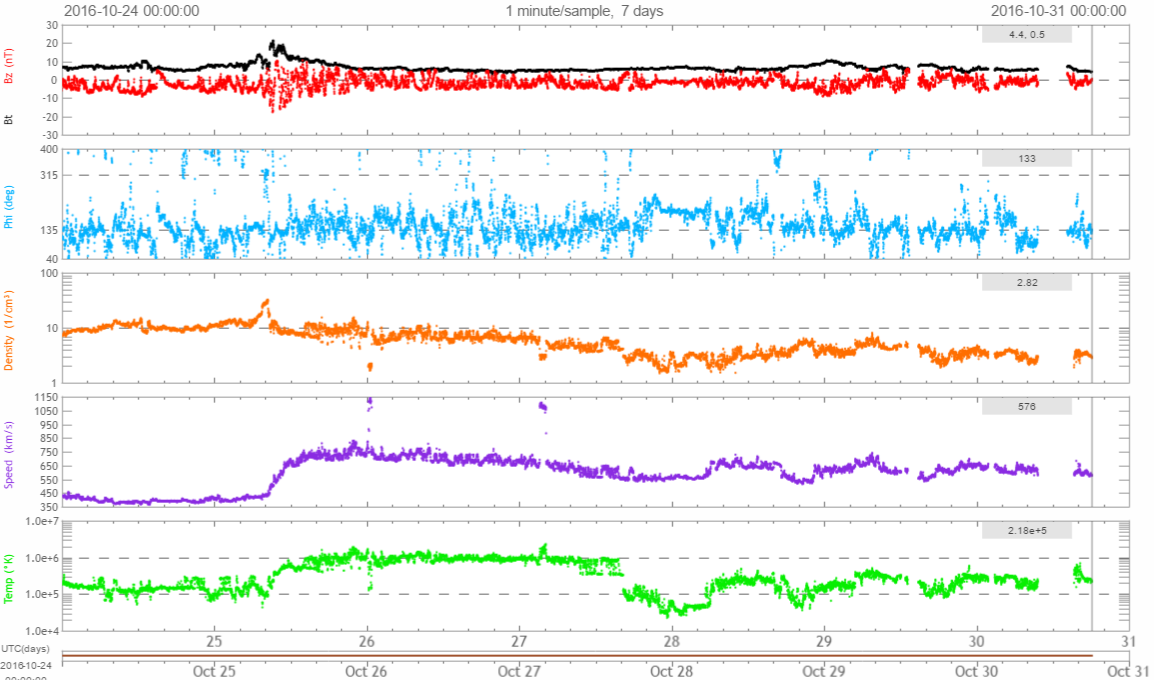
Bz (red graph in the top panel) strongly fluctuated between -18 and +10 nT from about 10 till 24UT, then mostly ranging between -6 and +6 nT for the rest week, with occasional sustained negative periods. The interplanetary magnetic field (IMF) was mostly directed away from the Sun (positive).
Minor to moderate geomagnetic storming was recorded on 25, 26, 27 and 29 October, with unsettled to active conditions reached on the other days. Kp was at major storming (Kp=7) during a single interval (12-15UT) on 25 October.
Review of ionospheric activity (24 Oct 2016 - 30 Oct 2016)
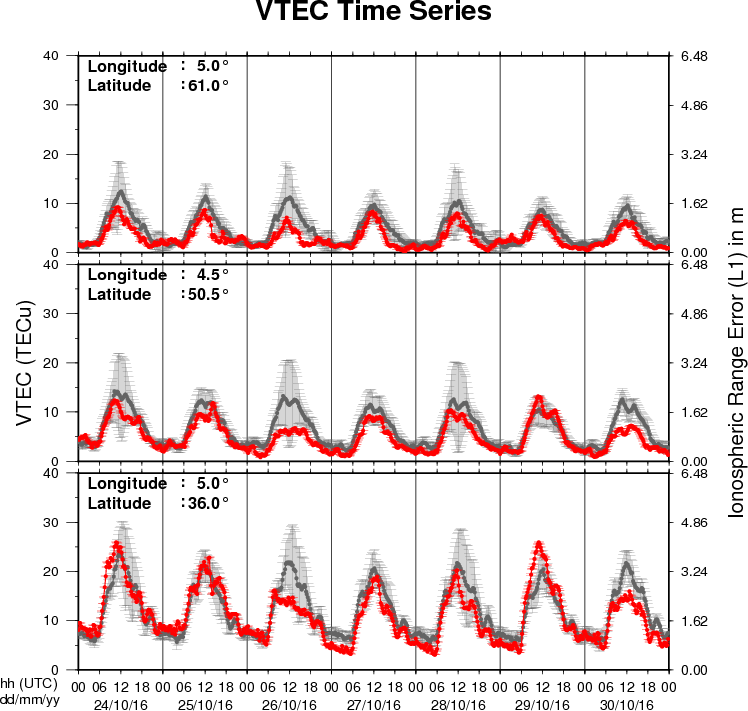
The figure shows the time evolution of the Vertical Total Electron Content (VTEC) (in red) during the last week at three locations:
a) in the northern part of Europe(N61°, 5°E)
b) above Brussels(N50.5°, 4.5°E)
c) in the southern part of Europe(N36°, 5°E)
This figure also shows (in grey) the normal ionospheric behaviour expected based on the median VTEC from the 15 previous days.
The VTEC is expressed in TECu (with TECu=10^16 electrons per square meter) and is directly related to the signal propagation delay due to the ionosphere (in figure: delay on GPS L1 frequency).
The Sun's radiation ionizes the Earth's upper atmosphere, the ionosphere, located from about 60km to 1000km above the Earth's surface.The ionization process in the ionosphere produces ions and free electrons. These electrons perturb the propagation of the GNSS (Global Navigation Satellite System) signals by inducing a so-called ionospheric delay.
See http://stce.be/newsletter/GNSS_final.pdf for some more explanations ; for detailed information, see http://gnss.be/ionosphere_tutorial.php
Future Events
For more details, see http://www.spaceweather.eu/en/event/future
European Space Weather Week in Ostend, Belgium
Start : 2016-11-14 - End : 2016-11-18
The ESWW is the main annual event in the European Space Weather
calendar. It is the European forum for Space Weather as proven by
the high attendance to the past editions. The agenda will be
composed of plenary/parallel sessions, working meetings and
dedicated events for service end-users. The ESWW will again adopt
the central aim of bringing together the diverse groups in Europe
working on different aspects of Space Weather.
Website:
http://www.stce.be/esww13/
4th SOLARNET Meeting: The Physics of the Sun from the Interior to the Outer Atmosphere, in Lanzarote (Spain)
Start : 2017-01-16 - End : 2017-01-20
The IV SOLARNET MEETING 'The physics of the Sun from the
interior to the outer atmosphere' will take place in Lanzarote
(Spain) from 16th to 20th of January 2017, organized by the
Instituto de AstrofÃsica de Canarias (IAC).
SOLARNET (High-resolution Solar Physics Network) is an EU-FP7
project coordinated by IAC with the aim of bringing together and
integrating the major European research infrastructures in the
field of high-resolution solar physics. SOLARNET involves all
pertinent European research institutions, infrastructures, and data
repositories. Networking activities, access to first-class
infrastructures and joint research and development activities are
being covered under SOLARNET to improve, in quantity and quality,
the service provided by this European community.
The purpose of this conference is to provide a coherent picture
of the Sun as a single physical system playing all the underlying
physical processes measured and observed in the solar atmosphere to
date.
Website:
http://www.iac.es/congreso/solarnet-4meeting/
Solar Orbiter Workshop 7: Exploring the solar environs in Granada, Spain
Start : 2017-04-03 - End : 2017-04-06
This event will be hosted by the Instituto de Astrofisica de
Andalucia - CSIC. Please mind that on April 7th the 20th SWT
meeting will take place at the same venue.
Website: Unkown
